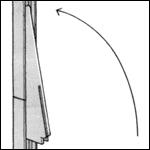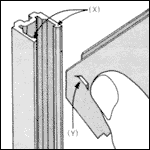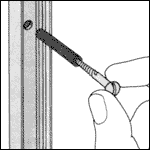Click Shelving
a better adjustable shelving system
Assembly Instructions
Spacing of Uprights
The distance between uprights should be decided in relation to
(a) anticipated loading,
(b) rigidity of shelf material,
and
(c) strength of wall fixings.
As a general rule, the greater the loadings and/or the more flexible the shelf material, the closer together uprights should be spaced. Typical spacing for general use is between 600 and 900mm – i.e around 750mm.


Wall Fixings
Secure fixing to the wall is essential, especially when uprights are widely spaced. For fixing to solid plaster or
masonry, fibre plugs are the most convenient, as they can be inserted through the holes in the uprights. For plasterboard or other cavity walls, however, special cavity fixings should be used. If there is doubt about the security of the fixings, it is good practice to raise the height of the uprights in order to locate two fixing points above the top shelf. Do not position load-bearing brackets higher than the top fixing screws.

Alignment of Shelves
Start with the lowest shelf, and make sure that it is level.
A spirit level can be used, but a ‘visual’ check is often more satisfactory, as this allows for building rregularities. Taking the bottom shelf as a reference line, fix the other brackets at the desired height. Bracket positions can be marked on uprights with a pencil when measuring.

Bracket Strength
Maximum recommended loading for any pair of Click brackets is 100 Kg distributed weight.
Fixing Uprights
Place upright in position on the wall, and mark position of top hole (which is about 75mm from the top of the upright). Drill wall using
No.8 (5mm) masonry drill,
to 38mm depth. Screw loosely through top hole, using 1½ ” No.8 roundhead wood screw and No.8 wall plug. Check that upright is vertical, and tighten top screw. Drill through other holes in upright (starting at the bottom) and secure, making sure that the plugs are at least 6mm beneath the wall surface. Fix the
next upright, measuring to ensure that it is parallel with the first. If uprights are
being fixed end-to-end, a bracket can be used as a jig to ensure alignment.

Fixing Brackets
To fix a bracket, press it into the upright channel at 45° until it “CLICKS”, making
sure that both projections
(Y) are located behind the lips (X). Pull it down to a horizontal position. To
adjust ~ height, raise
bracket from the horizontal to 45° and slide it up or down the channel. To remove bracket, raise to 45° and squeeze at base. NB: Brackets tend to be stiff when new; some firm pressure applied to the
front of the bracket will
bring it to the horizontal position. Please note also that Click brackets are made with a slight upward bias, so the angle between bracket and upright will normally be a degree or so less than 90° when shelves are not
loaded.

Fixing Shelves
It is not always necessary to fix shelves to brackets, as the weight on the shelf will often be sufficient to hold it in position – but it is essential where two shelves are being joined end-to-end on a single bracket. To fix a shelf to brackets, insert nurgle in slot at side of bracket, place shelf in position, and mark position of nurgle-hole with a pencil.
Remove shelf and make guide hole. Replace shelf and screw through nurgle with 10mm No.8 countersunk screw. NB: Position of brackets cannot be adjusted with nurgles fixed.

